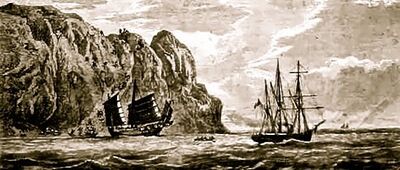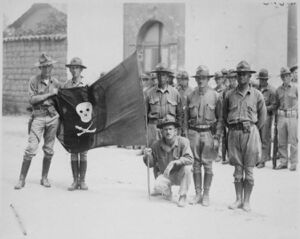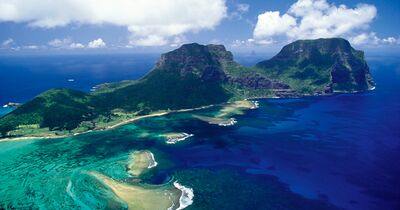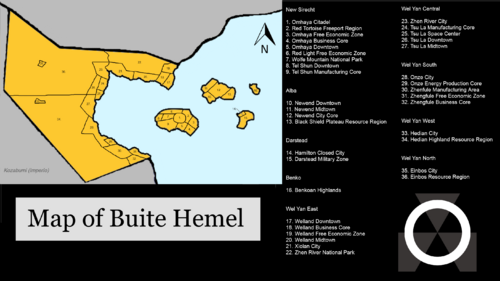Buite Hemel (Gruppa4)
The Free Ports of Buite Hemel 天堂外的自由港 | |
|---|---|
Motto: Black Flags Rise, Victory to the Fleet | |
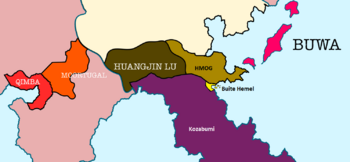 Map of Buite Hemel (yellow) and the surrounding region. | |
| Capital and largest city | Omhaya |
| Official languages | Cantonese English Afrikaans |
| Demonym(s) | Buite Hemelian Hemelian |
| Government | Unitary Pirate Syndicacy |
| Identity Classified | |
• Master Marshal | Muramasa Zhao |
| Legislature | The High Command of Buite Hemel |
| High Council of Provinces | |
| Autonomous Polity of Huaxia | |
• Assertion of Sovereignty | April 19, 1904 |
| Area | |
• Total | 65,000 km2 (25,000 sq mi) |
| Population | |
• 2020 estimate | 14,880,000 |
• 2016 census | 13,401,863 |
• Density | 228.9/km2 (592.8/sq mi) |
| GDP (nominal) | 2020 estimate |
• Total | 2.3 Trillion Satarii |
• Per capita | 154,000 Satarii |
| HDI (2020) | .84 very high |
| Currency | Satarius |
| Date format | YYYY-MM-DD |
| Driving side | left |
| Internet TLD | .bm |
Buite Hemel, officially known as The Free Ports of Buite Hemel, is an autonomous polity located on the southernmost outskirts of the region of Huaxia, sharing land borders with the Império polity of Kozabumi to the south, and the Huaxian polity of The Hairy Men of God to the north and west. Uninhabited until the 1800's when it was discovered by Huaxian pirates, Buite Hemel was originally a pirate port and later headquarters for many pirate syndicates who operated in the region. Subsequent immigration of pirates and outlaws from various nations lead to the development of a complex patchwork culture and identity. Following invasion attempts in the 1900's by Imperio powers, the loosely-organized pirate syndicates reformed into a nationalized collective lead by the Warlord Sovereign, who holds supreme power in the polity. Buite Hemel acts as an independent polity within the larger sphere of Huaxia, maintaining its sovereignty while coordinating with other Huaxian polities on matters of defence, trade, and culture. As the leader of a Huaxian polity, the Warlord Sovereign is considered a Banner King, and has appointed councillors to the Grand Huaxia Congress every year since its inception.
Today, Buite Hemel remains controversial on the world stage for its lax financial regulations and official sanctioning of piracy and mercenaries, which has resulted in the polity being a safe haven for outlaws, war criminals, and terrorists.
Etymology
The origins of the name Buite Hemel can be traced to some of the earliest pirates and mercenaries to immigrate to what is now the Polity of Buite Hemel. Afrikaans-speaking mercenaries named the land Buite Hemel which translates roughly to "Outside Heaven", in reference to the islands status as a land outside of the traditional authority of Huaxian 'Heaven', the unified political body of the cooperating nations of Huaxia.
History
Discovery & Early Settlement
The islands of Buite Hemel, despite their proximity to the Huaxian mainland and the shipping lanes favoured by traders, were not inhabited until an undetermined date in the 1800's when it was discovered by a pirate scouting expedition. The force moored off the islands there and sent parties ashore to some of the larger islands, establishing a small dock facility and settlement at what is now the capital of Omhaya. The shallow, calm waters surrounding the islands and the sub-tropical climate proved to be an ideal harbour for the pirates, and soon the pirate scouting force that had discovered the islands was joined by its mother force, and the archipelago soon grew busy as they settled and developed it as their base of operations.
Soon, the settlement grew more prosperous, enough that allied pirate fleets would come to dock for provisions and trade their spoils. The streets of the free port of Omhaya bustled with activity as pirates, mercenaries, traders, and outlaws of all stripes came and did their business there, with many of them settling there to take advantage of its natural harbour and freedom from authority.
Rise of Pirate Syndicates
It was at this time that the area became dominated by syndicates of pirate fleets, who would use the islands as a home port and staging area to launch raids along the coast and throughout the busy shipping lanes in the region. Through economic and/or defense unions between powerful captains and traders, huge fleets were raised, the majority of whom allied with one another through economic or military means. The large size and supreme might of the fleets proved to be devastating to all they encountered, and soon the syndicates became extremely prosperous. While the competition between the syndicates could become violent on the high seas, all agreed to respect the neutrality of Buite Hemel and it's immediate surrounding waters, and so all could still have it as a safe haven and free port.
As a result, the islands themselves grew in population and developed in popularity and luxury, becoming a place where wealthy pirates and merchants would gather to drink and whore and spend their fortunes. Services industries and farming bloomed, and the islands soon became properly developed. Brick buildings replaced old shanties, cobblestone roads spread across Omhaya, and Red Tortoise Seaport expanded exponentially to cope with the increasing volume of ships and travelers.
With new people and new enterprise came more money, the majority of which inevitably ended up in the pockets of the syndicates through fees, taxes, bribes, and tributes. This capital was used to fund new businesses and expeditions, further cementing the power and influence of the pirate syndicates across the seas from their seat of Buite Hemel.
Sovereignty Crisis
The turn of the 20th century saw the emergence of the first threat to the continued existence of Buite Hemel and the people who found themselves calling it their home. In 1901, a fleet of imperial powers from the South came to put down the pirates that had been reported to operate in the area. Upon finding the thriving settlements there, seeing opportunity, they attempted an amphibious invasion of the islands, attempting to bring it under their domain.
Accustomed to occasional raids from unallied pirates the defenders quickly retaliated, with hidden gun emplacements and rifle fire erupting from behind every rock and doorway. Within minutes, 96% of the main landing force had been cut down or captured. The fleet severely crippled, it limped away to report the incident to their superiors.
Understanding the potential ramifications of such an event, the most powerful pirate lords called together a council to decide what would be done. It is said that the decision was swift, as the mightiest warlord in the room simply pounded his fist on the table and declared: "I will be the one to break them upon the rocks. Those who take my orders and fight along side my fleet will be rewarded. Those who fight for the imperials or themselves will be beheaded". With that, an understanding was reached, and the warlord took command of a unified pirate fleet consisting of all free Hemelian ships and militia. The newly formed Hemelian Armed Forces dug into the islands, and prepared for the return of the Imperio forces.
In a terribly bloody campaign that lasted 15 months, a combined task force of several imperial nations attempted to invade and seize control of Buite Hemel. Victory was finally achieved in 1903, when the Imperial Capital ship was sunk following a daring infiltration mission. Twice crippled, the Imperial fleet was forced to withdraw all remaining troops over the next few days.
However, many English-speaking Imperio troops elected to stay behind on the islands following the ceasefire. Fearing punishment for their failure and also the grim prospect of their lives back home, many soldiers settled on the island, with the permission of the Warlord Sovereign. All told, over 20000 Imperio troops settled on the islands in the aftermath of the Second Battle of Buite Hemel.
Foundation and Constitutionalization
The temporary command structure that was established in response to the invasion crisis soon became the de-facto leadership in Buite Hemel, now known as The High Command of Buite Hemel. They had formally established The Armed Forces of Buite Hemel prior to the second battle of Buite Hemel, and continued to administer it following the ceasefire. Additionally, the payment issued to soldiers as additional compensation for continued loyalty against imperial bribes (tickets redeemable for high-quality gunpowder, a valuable and essential commodity for outlaws) became the default currency for all inhabitants of the isles.
On April 19, 1904, a year to the date of declaration of the ceasefire, the Hemelian High Command officially decreed the establishment of Buite Hemel as a Nation-State, asserting it's continuing mission to provide a safe haven for all pirates, soldiers, renegades, and outcasts from 'civil' society. It was on this date that the Constitution of Buite Hemel was personally written by the Sovereign Warlord, providing formal structure and understanding to Hemelian law. With an armed forces, currency, and formal government established, Buite Hemel took another step towards legal legitimacy as an independent power.
Rise of Nationalism
As the fledgling nation continued to grow in population, so to did the demands placed on the islands resources and infastructure. Crowding became an issue both on land and on the seas, and pirates soon found it mountingly difficult to turn a profit as theirs increased numbers meant each got a smaller share of bounty ships. At the same time, the culture of Buite Hemel, strongly influenced by the pirate history and contemporary military rule, begun to increasingly develop fueled by nationalism. Hemelians were well aware of the historical invasion attempt of the islands and the potential for future attacks, and so political sovereignty and military might became cornerstones of the Buite Hemelian identity. It was at this time that conscription was established, where all students graduating from high school are automatically enlisted in basic training before being assigned to duty for a period of 20-36 months.
Facing the demands of a growing population and struggling economy, and armed with a militant population and strong military, the High Command of Buite Hemel elected to push out further beyonds its waters to find new oppertunities.
Campaign in Wel Yan
1989 Economic Boom
Geography, Climate, & Environment
Buite Hemel is maritime nation comprised of four continental islands , a mainland region, and countless smaller islands and islets, covering a total area of approximately 65,000 km². The islands are largely sub-tropical in climate, with the summer rainy season bringing mighty storms that soak the islands for days in a torrential downpour. Strong oceanic currents drive warm water and nutrients to the islands, resulting in the region having world-class biodiversity, boasting an impressive 16,712 unique species present, including 730 species which are endemic to the region and its surrounding waters.
Conservation
Within the polity of Buite Hemel are two administrative disctricts set up as National Parks. Wolfe Mountain National park, located in New Sirecht, and Zhen River National Park, located in Wel Yan East, are administered directly by the High Command of Buite Hemel. The National Parks are designated as non-commercial and non-residential zones, meaning nobody can conduct business or legally register to live in those districts. Access to the National Parks is limited, with small visitor areas for camping and recreation set up on the boundaries of the parks. The remainder of the land of National Parks is considered resctricted access space, with noone allowed to enter without the express permission of the High Command of Buite Hemel. These rules are enforced by elements of the National Guard of Buite Hemel, notably the 1st & 2nd Border Jaeger Groups. By controlling access to the vast majority of the land in the national parks, the natural beauty and ecological sustainability of these regions are maintained to an unprecedented level, with the National Parks boasting world-renowned biodiversity.
Government & Politics
Military
See main article: The Armed Forces of Buite Hemel
The Armed Forces of Buite Hemel (AFBM) is responsible for defending the Polities sovereignty, enforcing its political will, and maintaining economic and physical access to important regions and opportunities across the world. It is composed of three seperate forces, divided into 67 constituent corps, with 972,000 total active & reserve personnel. Each of the three constituent forces is able to operate as a self-contained army, with land, sea, and air forces, as well as logistics, supply, and other necessary components. However, in practise, the National Guard primarily engages in national defence and sovereignty projection, the Expeditionary Forces primarily engage in foreign campaigns and perform contract work for international clients, and the Logistics Forces support and direct the former two forces.
Constituent forces of the Armed Forces of Buite Hemel
- The National Guard of Buite Hemel
- The Expeditionary Forces of Buite Hemel
- The Logistics Forces of Buite Hemel
Conscription & Training
Conscription is mandatory for all citizens. Following graduation of secondary school (age ~18 for most individuals), citizens are automatically enrolled in Armed Forces basic training, which begins two weeks following graduation. Basic training consists of 12 weeks of rigorous physical and mental testing, in addition to education in dogma, small-unit tactics, marksmanship, and equipment/vehicle operation. Officer candidates additionally attend Officer Qualification School following basic training, to refine their skills above and beyond and ensure their ability to lead effectively. During this time, all trainees are monitored to assess individual capabilities and latent talents. Surviving graduates of basic training are then assigned to one of the three branches of the AFBM based on capabilities and strengths observed during training.
Upon assignment to a specific branch, graduates undergo occupational specialty training such as attaining airborne qualification, combat medic certification, or pilot wings. Following completion of occupational specialty training, the graduates become soldiers proper, and fully enter the Armed Forces.
Conscripts serve their assignment for a period of 20-36 months depending on time considerations for specialist training. Upon completion of contract and honorable discharge, veterans are awarded their service weapon and receive a pension of 0.4x their base military salary, paid in monthly installments for a period of 50 years.
Law
As the Warlord Sovereign holds supreme power in Buite Hemel, all legislation is written by the Warlord Sovereign, Master Marshal, or other person empowered by the High Command of Buite Hemel. As all laws and codes in the polity are granted their power by the Warlord Sovereign, the leader is, in effect, above the law, and not subject to any of its principles, mandates, or punishments. As a result, the Warlord Sovereign is able to overrule, veto, and operate in any way they please. Therefore, legislation in Buite Hemel is intended to serve as a codified extension of the Warlord Sovereign's will and plan for the polity, to serve as a physical proof of the leaders decisions on specific issues.
While political freedom is completely outlawed, Hemelians enjoy a level of civil rights not seen by many inhabitants of the world. In addition to the administration of several Free Economic Zones that are devoid of taxation and customs regulations, Buite Hemel has legalized the possession, production, sale, and consumption of all psychoactive substances. Additionally, firearm ownership in Buite Hemel is largely unregulated, with the government allowing the sale, purchase, and use of all firearms and weapons that meet minimum quality and safety standards, and do not exceed 0.50 Gigajoules of muzzle energy or equivalent. However, individuals can apply for permits that allow the possession and use of firearms and weapons that exceed the maximum energy limits.
Prostituion is legalized by the High Command of Buite Hemel, with all sex workers registering for business licenses, the same as conventional companies or corporations register for permission to conduct business in Buite Hemel. The majority of brothels and sex workers are registered in the Red Light Free Economic Zone, taking advantage of historical cultural acceptance, and modern economic benefits of the FEZ. The Red Light district, as well as all other disctricts set up as FEZ's, also are home to a variety of casinos, resorts, bars, and other centers of adult entertain. This activity is legal in Buite Hemel, and as a result Buite Hemel attracts many visitors and tourists every year, many coming to partake in activities that would be illegal in more conservative polities.
Provinces
Buite Hemel consists of nine adminstrative sub-divisions known as provinces, with the nine provinces being further divided into 36 districts. Each province wields authority delegated to it by the High Command of Buite Hemel, and subsequently delegates municipal authority to its constituent districts. Districts manage local affairs, and coordinate with neighbor districts on provincial affairs as a part of a provincial Lower Council, with provinces accordingly coordinating on national affairs in the High Council. Ultimately, the Warlord Sovereign and the High Command of Buite Hemel holds ultimate power over any decision within the borders of Buite Hemel, and only delegates authority for administrative effeciency.
| Province | Capital | Population (2020 Estimate) | Area (km²) |
|---|---|---|---|
| New Sirecht | Omhaya Citadel | 3,840,000 | Area TBD |
| Alba | Newend Downtown | 2,440,000 | Area TBD |
| Darstead | Hamilton Closed City | Classified | Area TBD |
| Benko | Benkoan Highlands | 320,000 | Area TBD |
| Wel Yan East | Welland Downtown | 2,690,000 | Area TBD |
| Wel Yan Central | Zhen River City | 1,410,000 | Area TBD |
| Wel Yan South | Onze City | 2,300,000 | Area TBD |
| Wel Yan West | Hedian City | 1,100,000 | Area TBD |
| Wel Yan North | Einbos City | 780,000 | Area TBD |
External Relations
Economy
Free Economic Zones
Five districts within Buite Hemel are classified as Free Economic Zones, Special Economic Zones that are distinct from the rest of the polity in that all business and commercial activity conducted within is not subject to customs regulation, taxation, and other limitations placed on enterprise. The disctricts operate like self-contained cities, containing port facilities, manufacturing areas, warehouses, residential zones, retail zones, and business centers. Many foreign and domestic companies, corporations, and syndicates do business in the Free Economic Zones, with 90% of international commerce being conducted from Red Tortoise Freeport.
List of Free Economic Zones in Buite Hemel
- Red Tortoise Freeport Region
- Omhaya Free Economic Zone
- Red Light Free Economic Zone
- Welland Free Economic Zone
- Zhengfule Free Economic Zone
Black Market
The Black Market of Buite Hemel is an officially-sanctioned secure physical and electronic market, headquartered in the Red Tortoise Freeport Region. Under the protection of the Warlord Sovereign, it operates as a global center of black and grey commerce, allowing the exchange of good and services that would not be sanctioned within other polities. Therefore, the name 'black market' comes from it's status as a clandestine market within world economics, while being a legally-sanctioned market of Buite Hemel.
The Black Market is accessed either in-person or online, and upon the registry of an account, individuals and companies can begin to buy or sell goods and services. Notably, the Expeditionary Forces of Buite Hemel sells military contracts to international buyers, in effect making them a Private Military Company in addition to an Armed Forces.
Piracy
Piracy is the oldest and original business in Buite Hemel, with the polity directly owning its origins to the pirate syndicates that discovered and founded it, with many of these original pirate syndicates continuing to exist and operate in or from Buite Hemel. Privateering is state-sanctioned in Buime Hemel, with The High Command of Buite Hemel issuing letters of marque to qualifying individuals. Many privateers operate as a part of larger syndicate fleets, and own complex networks of logistic and operation facilities in Buite Hemel, which combined with Buite Hemels many Free Economic Zones, allows them operate freely from the polity.
Privateering in Buite Hemel is a diverse business, with each fleet operating in different physical or economic areas. While the majority of fleets engage in conventional hijacking and robbery, some specialized privateer syndicates provide contract services to clients; examples of contracts include private security, asset acquisition, reconnaissance, and sabotage.
Non state-sanctioned piracy is not explicitly illegal in Buite Hemel. While the Armed Forces of Buite Hemel operates two Anti-Piracy Corps, in practise pirates are free to operate and resupply in Buite Hemel, so long as they do not attack ships, settlements, and other assets owned or claimed by Buite Hemel.
Entertainment industry
Gambling, prostitution, and drug use have all been present in Buite Hemel from the time of first settlement. As a pirate port without formal law, people could gamble, engage in prostitution, and manufacture, distribute, and consume drugs without fear of persecution. By the time of the polities founding, the 'entertainment industry' as it is now referred to accounted for upwards of 60% of the economic activity in the polity, a stunning feat taking into account the considerable volume of goods being traded through Red Tortoisse Free Economic Zone (then known as the Red Tortoisse Freeport).
As a result, the entertainment industry continued following the inception of the polity, however for the first time it was subject to government regulation. In addition to the taxation of all entertainment activities, specific provisions were legislated to ensure the entertainment industry did not begin to negatively impact the polity or it's inhabitants. Gambling houses were inspected to verify financial records and to check that all dice and cards were fair and not rigged in any way. Prostitution was regulated and limited to brothels that maintained proper business licenses like other businesses. Additionally, prostitutes were mandated to undergo regular STI screenings. Drug use remained legal, with legislation being passed that required all drugs to meet or exceed minimum quality standards in order to be sold commercially.
Contemporarily, the entertainment industry remains one of the largest contributors to the Hemelian economy, and is estimated to draw upwards of 40 million tourists to Buite Hemel each year.
Demographics
The people of Buite Hemel, referred to as 'Hemelians', are largely comprised of the descendants of the original Huaxians who discovered and founded the polity. The initial population consisted entirely of pirates, outlaws, whores, and their offspring, subsequent waves of immigration arrived in the area, and soon the population expanded, with many other ethnic groups settling the area. However, Huaxians remain the single largest ethnic group in the polity, accounting for 89% of persons.


